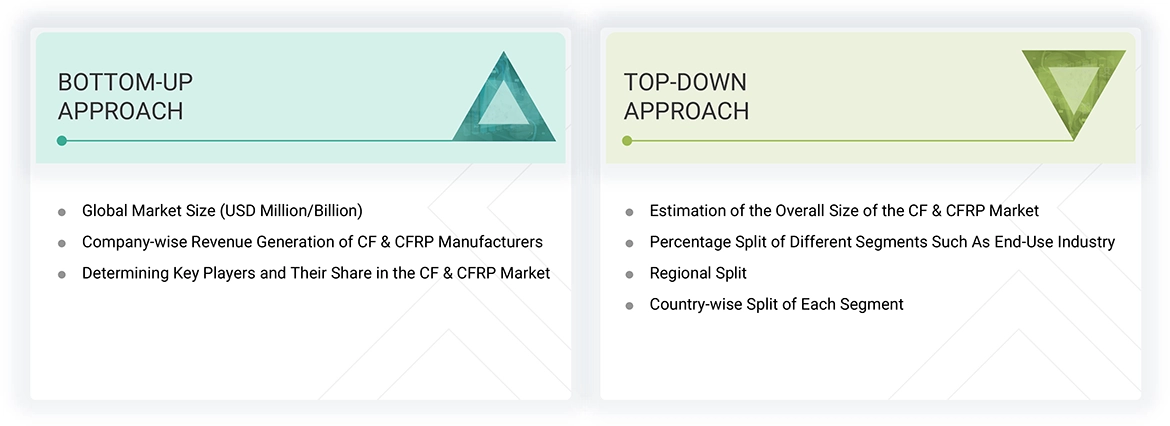The study involves two major activities to estimate the current market size for the CF & CFRP market. Extensive secondary research was conducted to gather information on the market, peer market, and parent market. The next step was to validate these findings, assumptions, and sizing with industry experts throughout the value chain via primary research. Both top-down and bottom-up approaches were utilized to estimate the overall market size. Following that, market breakdown and data triangulation were applied to estimate the market size of segments and subsegments.
Secondary Research
Secondary sources referred to for this research study include financial statements of companies offering CF & CFRP and information from various trade, business, and professional associations. Secondary research has been used to obtain critical information about the industry’s value chain, the total pool of key players, market classification, and segmentation according to industry trends to the bottom-most level and regional markets. The secondary data was collected and analyzed to arrive at the overall size of the CF & CFRP market, which was validated by primary respondents.
Primary Research
Extensive primary research was conducted after gathering information about the CF & CFRP market scenario through secondary research. Several primary interviews were held with market experts from both the demand and supply sides across major regions, including North America, Europe, Asia Pacific, the Middle East & Africa, and Latin America. Primary data was collected through questionnaires, emails, and phone interviews. The primary sources from the supply side included various industry experts, such as chief experience officers (CXOs), vice presidents (VPs), business development or marketing directors, product development or innovation teams, relevant key executives from the CF & CFRP industry, system integrators, component providers, distributors, and key opinion leaders. Primary interviews aimed to gather insights such as market statistics, revenue data from products and services, market breakdowns, market size estimations, market forecasting, and data triangulation. Primary research also provided an understanding of the various trends related to precursor type, source, resin type, manufacturing process, end-use industry, and region. Stakeholders from the demand side, including CIOs, CTOs, CSOs, and installation teams of customers or end users seeking CF & CFRP services, were interviewed to gain insight into the buyer’s perspective on suppliers, products, component providers, and their current usage of CF & CFRP, as well as the future outlook of their business that will impact the overall market.
Breakup of Primary Research:

To know about the assumptions considered for the study, download the pdf brochure
Market Size Estimation
The research methodology used to estimate the size of the CF & CFRP market includes the following details. The market sizing was undertaken from the demand side. The market was upsized based on the demand for CF & CFRP in different end-use industries at the regional level. Such procurements provide information on the demand aspects of CF & CFRP for each end-use industry. For each end-use industry, all possible segments of the CF & CFRP market were integrated and mapped.

Data Triangulation
After arriving at the overall size from the market size estimation process explained above, the total market was split into several segments and subsegments. The data triangulation and market breakdown procedures explained below were implemented, wherever applicable, to complete the overall market engineering process and arrive at the exact statistics for various market segments and subsegments. The data was triangulated by studying various factors and trends from the demand and supply sides. Along with this, the market size was validated using both the top-down and bottom-up approaches.
Market Definition
CFRP materials are made from two or more different materials (such as carbon fibers and matrix materials). In CFRP, carbon fibers are used as reinforcement materials, and resins such as thermoset and thermoplastic are used as matrix materials. These materials offer an excellent strength and stiffness-to-density ratio and have other physical properties. They are used in various end-use industries, such as aerospace and defense, wind energy, sports goods, and pipes and tanks.
Stakeholders
-
CF & CFRP Manufacturers
-
CF & CFRP Distributors and Suppliers
-
Universities, Governments, and Research Organizations
-
Associations and Industrial Bodies
-
R&D Institutes
-
Environmental Support Agencies
-
Investment Banks and Private Equity Firms
-
Research and Consulting Firms
Report Objectives
-
To define, describe, and forecast the CF & CFRP market size in terms of volume and value
-
To provide detailed information regarding the key factors, such as drivers, restraints, opportunities, and challenges influencing the market growth
-
To analyze and project the global CF & CFRP market by precursor type, source, resin type, manufacturing process, end-use industry, and region
-
To forecast the market size concerning five main regions (along with country-level data), namely, North America, Europe, Asia Pacific, the Middle East & Africa, and Latin America, and analyze the significant region-specific trends
-
To strategically analyze micromarkets with respect to individual growth trends, prospects, and contributions of the submarkets to the overall market
-
To analyze the market opportunities and the competitive landscape for stakeholders and market leaders
-
To assess recent market developments and competitive strategies, such as agreements, contracts, acquisitions, and product developments/product launches, to draw the competitive landscape
-
To strategically profile the key market players and comprehensively analyze their core competencies



Nicolas
Apr, 2018
Carbon Fiber market with automotive as key application.
Toshi
Feb, 2018
Sepcific information on Carbon Fiber Reinforced Plastic market for aircraft components applications.
Anucha
Nov, 2017
Require report arounf CF,a CFRRP, 3D prinitng, 4D printing in energy storage and IT material.
Nikita
Jun, 2018
General information on CFRP (thermosetting) in Prosthetics.
Prabal
Feb, 2018
Carbon Fiber Pricing.